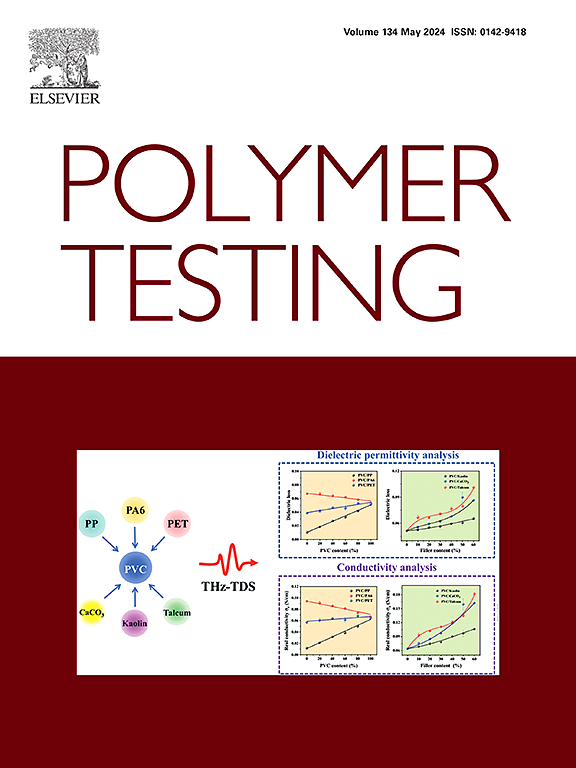High-temperature insulating polyimide aerogels with a hierarchical porous hyper-cross-linked structure derived from aqueous polymerization of mesostructured silica-grafted Poly(amic acid) salt
IF 5
2区 材料科学
Q1 MATERIALS SCIENCE, CHARACTERIZATION & TESTING
引用次数: 0
Abstract
Polyimide (PI) aerogels have garnered significant interest in thermal protection applications because of their excellent high-temperature resistance and broad operational range. Nevertheless, there are still research challenges, such as the extensive use of organic solvents, shrinkage during drying, and the need for improved thermal/electrical insulation and mechanical properties. Addressing these challenges is crucial for enhancing the practical application of PI aerogels in demanding environments. Herein, we propose a facile, green, and scalable method for fabricating freeze-dried PI aerogels via the aqueous polymerization of amino-functionalized mesoporous silica-grafted poly(amic acid) salts (PAAS-g-AMS). Our findings demonstrate that water-borne PI (W-PI)-g-AMS aerogels have a three-dimensional covalent network with a macroporous/mesoporous architecture, which minimizes molecular chain slippage and shrinkage during thermal imidization. The W-PI-g-AMS aerogels possess excellent properties, such as high porosity (>91 %), a low bulk density (122.4 mg cm−3), minimal shrinkage (8.1 %), good compressive strength (6.15 MPa) and modulus (1.86 MPa), a high degradation temperature (Td5 % = 599.4 °C), a low fire growth rate index (0.075 W g−1 s−1), low thermal conductivity (0.08241 W m−1 K−1), and a remarkably low dielectric constant (Dk = 1.25 at 1 MHz) and dissipation factor (Df = 0.001 at 1 MHz), indicating their potential for use as substitute materials for thermal and electrical superinsulation in the aerospace and transportation industries in extreme environments.

高温绝缘聚酰亚胺气凝胶具有分级多孔超交联结构,由介结构硅接枝聚胺酸盐水相聚合而成
聚酰亚胺(PI)气凝胶由于其优异的耐高温性能和广泛的工作范围,在热保护应用中引起了极大的兴趣。然而,仍然存在研究挑战,例如有机溶剂的广泛使用,干燥过程中的收缩,以及需要改善热/电绝缘和机械性能。解决这些挑战对于提高PI气凝胶在苛刻环境中的实际应用至关重要。在此,我们提出了一种简单、绿色、可扩展的方法,通过氨基功能化介孔硅接枝聚胺酸盐(PAAS-g-AMS)的水聚法制备冻干PI气凝胶。我们的研究结果表明,水性PI (W-PI)-g-AMS气凝胶具有三维共价网络,具有大孔/介孔结构,可以最大限度地减少热亚酰化过程中的分子链滑移和收缩。W- pi -g- ams气凝胶具有高孔隙率(> 91%)、低体积密度(122.4 mg cm−3)、最小收缩率(8.1%)、良好的抗压强度(6.15 MPa)和模量(1.86 MPa)、高降解温度(Td5 % = 599.4℃)、低火焰生长速率指数(0.075 W g−1 s−1)、低导热系数(0.08241 W m−1 K−1)、极低的介电常数(1 MHz时Dk = 1.25)和耗散系数(1 MHz时Df = 0.001)等优良性能。表明它们在极端环境下作为航空航天和运输行业的热和电超绝缘替代材料的潜力。
本文章由计算机程序翻译,如有差异,请以英文原文为准。
求助全文
约1分钟内获得全文
求助全文
来源期刊

Polymer Testing
工程技术-材料科学:表征与测试
CiteScore
10.70
自引率
5.90%
发文量
328
审稿时长
44 days
期刊介绍:
Polymer Testing focuses on the testing, analysis and characterization of polymer materials, including both synthetic and natural or biobased polymers. Novel testing methods and the testing of novel polymeric materials in bulk, solution and dispersion is covered. In addition, we welcome the submission of the testing of polymeric materials for a wide range of applications and industrial products as well as nanoscale characterization.
The scope includes but is not limited to the following main topics:
Novel testing methods and Chemical analysis
• mechanical, thermal, electrical, chemical, imaging, spectroscopy, scattering and rheology
Physical properties and behaviour of novel polymer systems
• nanoscale properties, morphology, transport properties
Degradation and recycling of polymeric materials when combined with novel testing or characterization methods
• degradation, biodegradation, ageing and fire retardancy
Modelling and Simulation work will be only considered when it is linked to new or previously published experimental results.
 求助内容:
求助内容: 应助结果提醒方式:
应助结果提醒方式:


